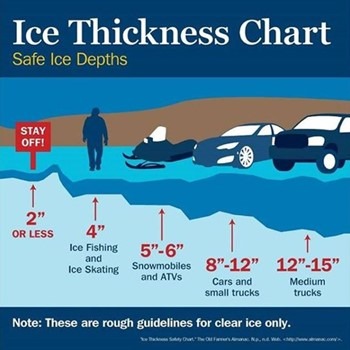
21 Dec Ice safety
Ice safety
Be careful on the ice in winter. It is difficult to determine the strength or thickness of ice simply by its appearance. Temperature changes can also alter the ice from day to day. So remember, when in doubt, don’t go out!
Safety Tips
If you decide to go out on the ice, keep the following safety tips in mind.
1. Consider the conditions
Carefully monitor the weather conditions. Snow can hide the water that would be on the ice, disorient you and leave you without landmarks.
Do not travel on ice in early and late winter, as conditions are more likely to be hazardous. Avoid melting, thawed, recently refrozen ice or ice near white water. Avoid travelling on the ice at night. Reduced visibility increases the danger and makes it difficult to see if the ice is fragile or cracked.
Always check the thickness and stability of the ice before going out.
2. Plan ahead
Do not walk alone on the ice. Leave a travel plan with someone that shows where you’re going, for how long, and when you’ll be back. If you cannot leave a travel plan with someone, leave a note on your car windshield.
Do not drink alcohol while on the ice. Alcohol impairs judgment and reduces your ability to stay warm in cold weather.
3. Preparations
Carry a personal safety kit including:
- A lighter;
- Waterproof matches;
- A magnesium fire starter;
- A pocket knife;
- A whistle;
- A cell phone in a waterproof pouch.
Carry a fully charged GPS, compass and map when needed, and know how to use them.
Loosen buckles, and fasteners and undo belts of any gear so you can easily remove them if you fall in the water.


